As we tell every new client, everything is connected on the web: social media, search engines, AI, and of course, hundreds of thousands of users waiting to become customers. The best way to reach them? Diversify.
The use of social networks to search for information about products and services is on the rise. It’s no longer enough to apply traditional SEO techniques; Social Media SEO is a must.
Does this mean the death of search engines? Absolutely not—it represents an opportunity to enhance your visibility on the web and reach your clients. How can you leverage this? Keep reading to discover a step-by-step guide.
What is Social Media SEO?
Today, we spend more time looking at screens than away from them. Reaching your customers online should be a piece of cake, right? Well, not exactly, but it’s not impossible either—especially when SEO (Search Engine Optimization) enters the picture.
SEO encompasses various techniques to improve a website or post’s organic (unpaid) visibility. And it’s not just about visibility; as a digital marketing strategy, it also aims to turn users into customers.
One of the first steps in our SEO process is to ask clients if they have social media accounts. Why? Because these can be used to improve their organic search ranking.
Social Media SEO combines the practices and tools of “traditional” SEO with techniques to optimize profiles and content on specific social networks. Not only does each network favor a particular format and type of information, but it also targets a unique audience.
It seems like a lot of work—and it is. But it’s worth it. Why? Because, in broad terms, social networks allow you to expand your website’s reach, improving its visibility and creating a consistent brand experience.
Both aspects are crucial for building user trust in your brand, leading them to search for it on social networks, search engines, or share it with others. After all, clients don’t only interact with a brand through its social media, website, or mailing campaigns.
That’s why, when we identify the channels our clients use to reach their audience, we consider how to optimize them, always ensuring consistency across platforms to improve organic ranking.
This improvement can occur both directly and indirectly. In other words, social media SEO serves as a strategy for web SEO. Let’s take a closer look at what we mean:
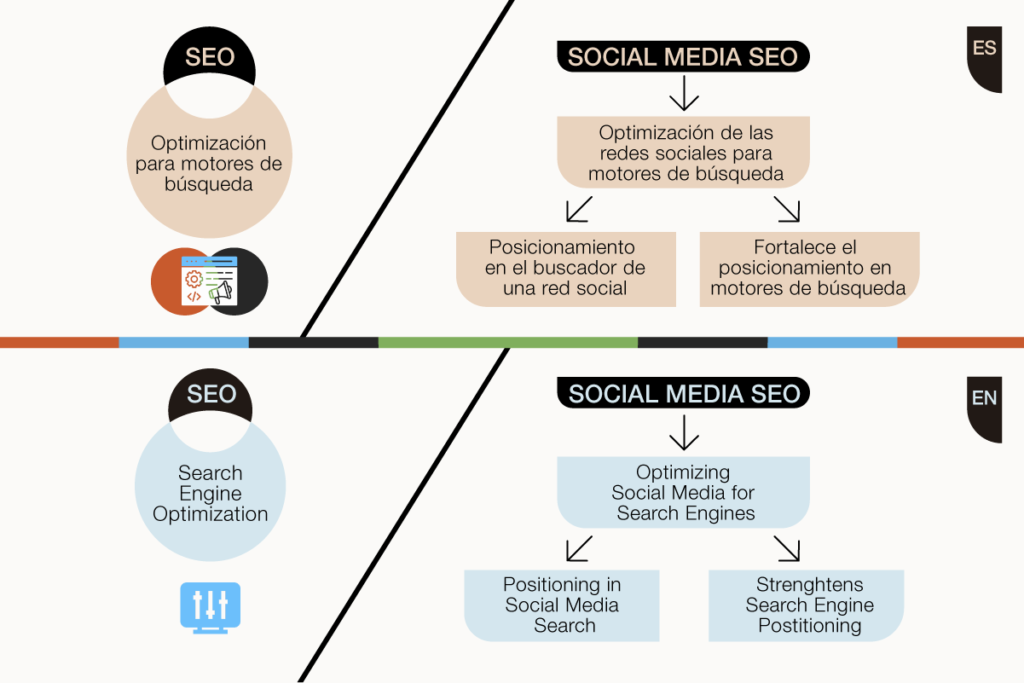
The Relationship Between SEO and Social Media
By now, you’ve probably realized that (in our humble opinion) a good SEO process is comprehensive. Search engine optimization isn’t limited to search engines like Google and Bing; it also includes other platforms for searching, social networks, and websites.
Of course, search engines index both website and social media pages. So, as we’ve mentioned, everything stays connected on the web. For us, this means not only ensuring brand experience consistency but also optimizing accounts across different platforms.
Now, social media is more than just a website. The ability to have followers, receive likes, share posts, and incorporate various formats makes it unique. To what extent all this affects a site’s ranking is one of the major debates of the century—or rather, it was, as it now seems largely resolved.
Do Social Media Platforms Affect SEO?
Originally, social media had a direct influence on web search results. Today, Bing acknowledges that social signals can be used to modify search results. However, Google crawls social media as if it were a regular website.
In other words, for Google, social media doesn’t have a direct impact on organic ranking. Yet, it does influence it indirectly. This mainly occurs because social media can boost a site’s credibility and drive traffic to it.
Moreover, in 2018, Hootsuite conducted a study that showed a positive correlation between a company’s engagement and interactions on social media and its ranking in search results.
In this regard, social signals, such as user engagement with a post, can impact its ranking. Backlinks and the amount of web traffic generated also contribute to website ranking—though indirectly.
To achieve this, it’s important to produce quality content that users want to share or that attracts their attention enough to drive them to your website. Even Google acknowledges this in its guidelines for creating SEO content. Additionally, a profile’s account should be optimized.
In other words, relying solely on the algorithm isn’t enough. When results are the goal, Social Media SEO is essential.
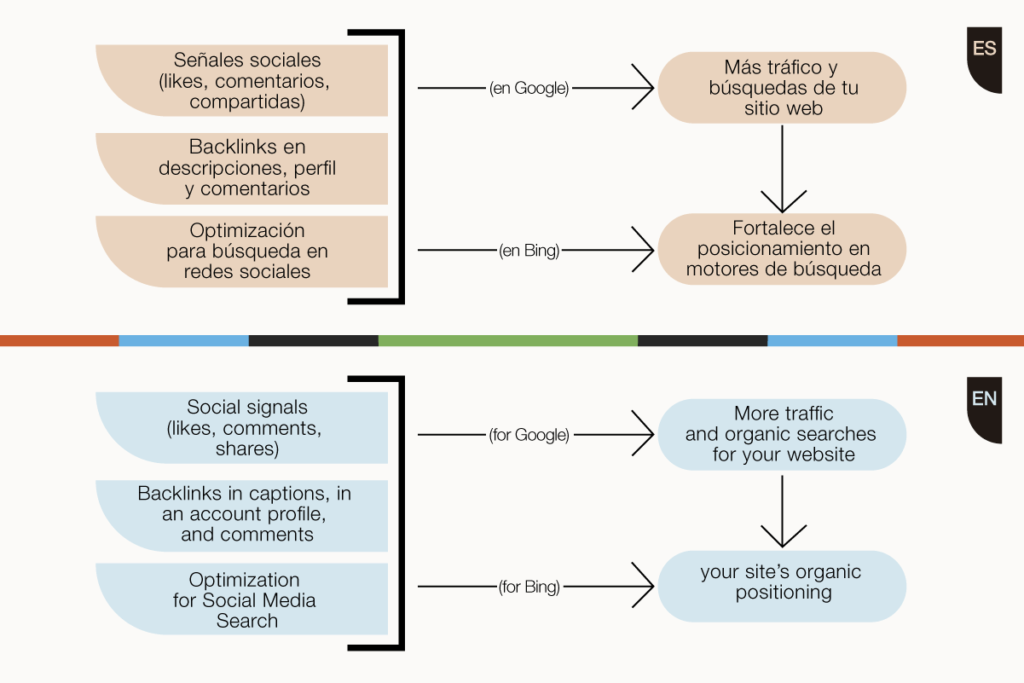
Increasing Organic Traffic Through Social Media
The influence of your presence and interactions on social media on search results is mostly indirect. This is because Google doesn’t consider social signals (likes, shares, reposts, or reactions) as relevant factors for generating its results pages… But let’s break it down.
As social media improves a site’s positioning on search engines, it can also boost its organic traffic—that is, the number of visits it receives by appearing among unpaid search results. The big advantage of this type of traffic is that it consists of users genuinely interested in what’s being offered—in other words, potential customers.
But let’s get to the point: how exactly does social media increase a website’s organic traffic? Let’s see.
First, applying Social Media SEO strategies to optimize content and social media profiles enhances the visibility and reach of an account—or rather, of the business or brand it represents. This leads to:
- More traffic to your website if, for example, you include a link in your profile bio. Creating relevant content encourages sharing, further increasing your site’s reach.
- More users becoming familiar with your brand and searching for it by name on a search engine. This not only improves your site’s ranking in search results but also helps establish your brand identity.
- Greater interaction with your social media content, which builds trust among other users and enhances your site’s reputation. Each mention of your site on social media or the web is an opportunity to increase traffic and, with it, your site’s ranking.
Google (and other search engines) consider these factors as indicators that a site is high-quality and addresses certain user queries. As a result, it will tend to rank higher in results pages for those searches.
Effective Social Media SEO Strategies
Once we analyze how clients are found online, it’s time to sit down and design optimization strategies. Since today we’re feeling generous, let us share some steps we follow at this stage of our SEO process:
First and foremost, it’s essential to define your target audience and identify which social networks will help you reach them. The platform you choose should also match the type of content you want to promote. For example:
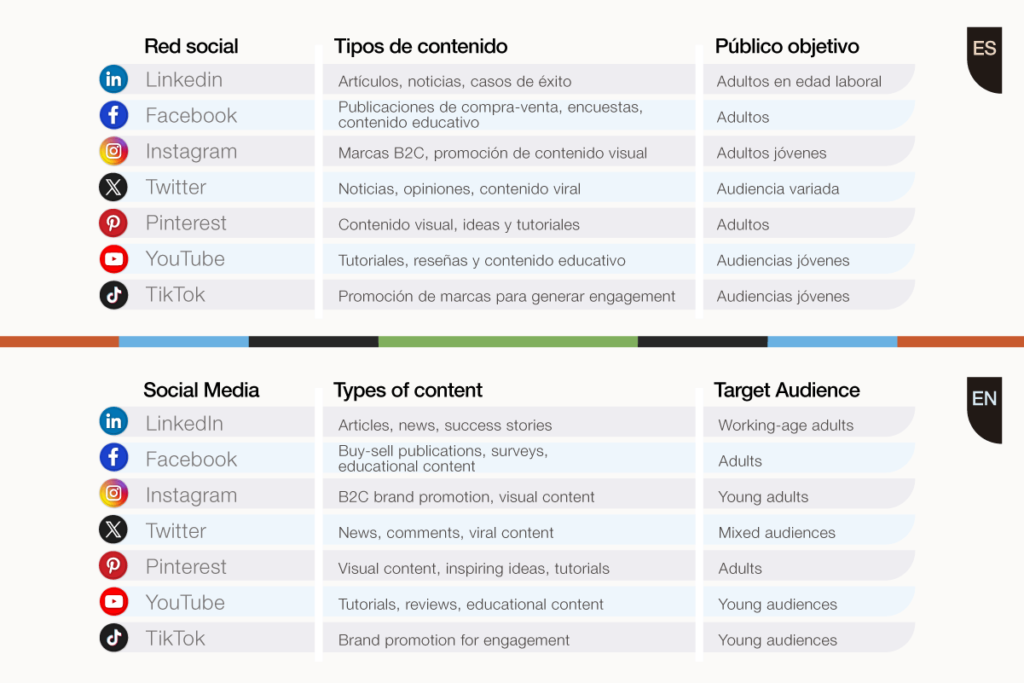
It’s also advisable to set goals and decide which Key Performance Indicators (KPIs) you’ll use. These will help you determine whether you’re achieving your objectives. For example, the number of leads you generate over a given period or your engagement rate.
Keep in mind that, as a digital marketing strategy, Social Media SEO also relies on metrics and search trends. Therefore, it’s wise to use tools that allow you to track your campaigns.
This way, you can optimize your posts based on the traffic, engagement, and trend data you collect, refining both the types of content to publish and the strategies used. Some key metrics to pay attention to include:
- Number of followers
- Number of likes
- Comments
- Impressions and reach of the post
- Post shares
- Click-through rate
- Brand mentions
Social Profile Optimization for SEO
One important organic ranking strategy on social media that needs closer examination is the optimization of social media profiles. While creating a profile for Instagram differs from LinkedIn, Twitter, or YouTube, some general recommendations apply across various platforms.
When designing a Social Media SEO campaign, we start by ensuring that your profile helps (potential) customers find you easily and quickly. To achieve this, it’s advisable that your account name and bio include industry-specific keywords to clearly communicate your offerings.

This will help your profile appear in search results within the network and even in search engine results pages, boosting your visibility…which can lead to new clients, provided your Social Media SEO strategy is compelling.
More specifically, your profile bio should be clear, concise, and informative. It serves to establish your brand personality, keeping consistency with your website.
In this regard, a well-crafted bio not only needs to include keywords related to your offerings but also a value proposition—what sets you apart from your competition.
This section is also an ideal place to include links to your website, which can help increase site traffic, thereby improving its ranking. While social media links are considered no-follow, they still drive users to your site, which helps search engines recognize its value.
Your profile should also serve as an opportunity to establish your brand through effective branding. To achieve this, ensure that the tone, style, and graphic elements you use are consistent across all your social media accounts.
Creating Content That Boosts SEO
Another key Social Media SEO strategy is producing quality content that encourages users to interact with and share your posts. Generally, visually appealing content tends to be shared more often, especially if it’s educational or informative.
In addition, using hashtags, tags, and keywords in titles and descriptions helps boost content visibility. If you create content on topics with high relevance and popularity, your posts’ reach will expand even further.
A great technique to create content that enhances your search engine ranking is to research the latest social media trends and link them to your offerings.
However, remember that you don’t always have to create content from scratch. Depending on the topic, you can produce evergreen posts and update them with different formats or angles across your social media channels.
Social Media SEO results don’t arise solely from trends; they build up over time. And they’re not aimed at just anyone—they’re directed specifically at your target audience! For this reason, it’s better to focus on each post addressing a need your customers may have, rather than only following trends.
Finally, incorporating clear calls to action and creating interactive content (e.g., dynamic infographics) is a good way to enhance audience engagement.
Some of our most successful Social Media SEO campaigns leveraged polls and challenges to boost user engagement with our clients’ accounts. This not only strengthened brand interaction but also amplified content reach, embodying the principles of viral marketing and driving a substantial increase in web traffic.
Communication Strategies
Social Media SEO goes beyond optimized posts for user sharing and an envy-worthy profile. Regular interaction with your customers and colleagues, as well as seeking potential collaborators, is another way to strengthen your brand’s reputation and visibility.
To optimize your LinkedIn profile, for example, it’s essential to follow professionals and companies in your field. Commenting on their posts can help you get noticed by their followers and establish new contacts. Additionally, it helps you receive job suggestions and contact recommendations relevant to your industry.
Creating broadcast channels and offering newsletter subscriptions is another strategy to build trust in your business while maintaining consistent communication with your followers. Although Facebook discontinued its newsletter service in 2022, Instagram and Telegram still allow you to create user communities where you can send targeted content.
Network-Specific Strategies
Let’s briefly review some Social Media SEO strategies that can help you optimize your accounts for each of today’s most popular social networks:
- Instagram: The functions of this platform have increasingly shifted towards a commercial space, particularly for brand discovery. The ability to publish various content formats (like Threads, reels, and stories) and access specific metrics makes Instagram an ideal option for boosting brand visibility. Strategically organizing your profile content will enhance the customer experience and increase engagement.
- Facebook: Like other Meta platforms, Facebook offers paid ad options. However, it also provides plenty of room for organic search optimization strategies. We recommend including CTA (call-to-action) buttons on your profile and making posts with enriched links (that have previews). Additionally, join relevant Facebook Groups where you can connect with users interested in your offerings or colleagues for networking.
- TikTok: The target audience here mainly consists of teens and young adults, but TikTok also provides growing opportunities for businesses, especially for visibility. It’s advisable to use hashtags to align with the latest trends and include CTAs that drive traffic to your website to maximize this platform. Another option is creating short videos that provide information about your offerings or business.
- X (formerly Twitter): Leaving Meta’s Holy Trinity, we come to X, where conversation and debate flourish—not just among users but within the platform itself. This network is ideal for sharing news about your business or company and opinions. Engaging in trending posts using hashtags and enriched links can boost visibility and drive traffic to your website.
- YouTube: Adding links to your website in video descriptions, along with a strong CTA, is a good Social Media SEO strategy for YouTube. Including tags and keywords in your video titles and descriptions will help them appear in search results on this platform, reaching more users. YouTube Shorts is also a great way to create viral content.
- LinkedIn: Publishing quality articles with specific keywords allows you to establish yourself as a professional in your field. Commenting on posts by established professionals is also an effective way to get noticed.
- Pinterest: The outlier of the Meta family but a hidden gem for Social Media SEO. This platform allows you to drive traffic to a webpage by associating links with a specific pin (or image). Creating boards to organize your account’s content makes it easier for users to find on this network.
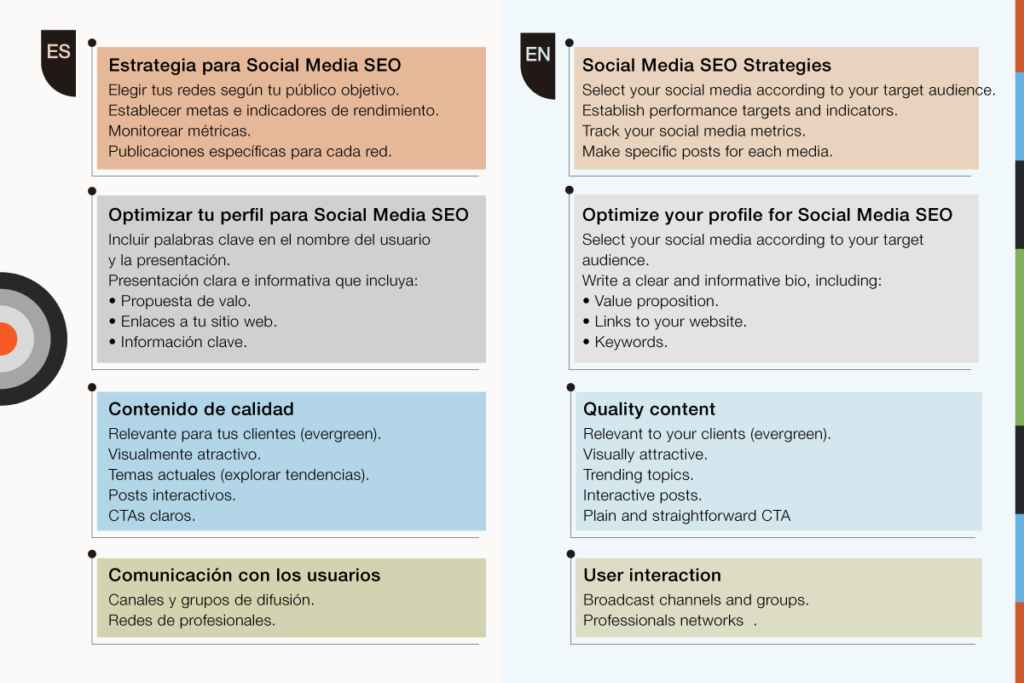
Common Social Media SEO Mistakes and How to Avoid Them
Achieving good organic positioning on social media is not as intuitive as it seems. It is, after all, a form of SEO. And SEO isn’t intuition—it’s metrics. But even in such a technical field (or rather, especially in one), mistakes can happen.
Every solid SEO process anticipates a few mistakes. More importantly, it also anticipates how to fix them. Let’s look at some common mistakes we come across when auditing a new SEO client and, most importantly, how we correct them.
Not Optimizing Descriptions and Links
One of Social Media SEO’s main purposes is to create an additional entryway to your website. Thus, failing to include direct links to your site or keywords related to it in highly visible areas (such as your profile bio or post descriptions) is definitely a mistake.
Another potential error with links on social media is failing to ensure they are up-to-date. Changing the profile link to direct users to specific promotion landing pages, for example, maximizes the benefits of social media-driven traffic.
To organize multiple links on one profile, it’s advisable to use a link tree. This tool helps reduce bounce rates by preventing users from landing on the wrong page and immediately exiting. It also provides visibility to different sections of your website.
Excessive use of hashtags or using irrelevant or oversaturated hashtags is another Social Media SEO mistake. Why? Because it decreases the quality of interactions and weakens your content’s authority in the eyes of both users and search engines.
Keep in mind that social network search engines, as well as those like Google and Bing, prioritize quality content. Therefore, each element in your posts should be consistent and relevant.
Posting Duplicate Content
When we talk about “duplicate content,” we don’t mean posting the same post twice on a social network. We mean posting the same content, without any modifications, across multiple social networks.
On one hand, this is counterproductive for Social Media SEO since each social network has its own style codes and posting formats, targeting a more or less specific audience.
Additionally, platforms owned by the same company may penalize content duplication. This also reduces user engagement, as people tend to ignore posts they’ve already seen, even if it was on a different network.
To resolve this issue, it’s essential to adapt your content for each social network. For Facebook and LinkedIn, for example, you can create longer, more formal posts. On TikTok and Instagram, you might upload short videos that summarize the original article in a simplified way.
Another mistake is not considering the different ways users access each network when adapting content. While LinkedIn and Facebook are often used on PCs, Instagram, X, and TikTok tend to be accessed on mobile devices. Adjusting text length and image quality for each format will enhance the user experience, building more trust in your brand.
Errors by Omission
In the past, there were sins of omission. So, for Social Media SEO, let’s talk about “errors by omission”, which may not lead to divine punishment but can harm your web ranking.
The first (and most important) is not incorporating metrics when designing an SEO strategy for social media. Reviewing current trends in your field or monitoring campaign results is essential if you want to achieve good outcomes. In the next section, you’ll find some tools to simplify this process.
A second error by omission that can undermine the effectiveness of your Social Media SEO strategies is failing to engage with your audience. Over time, this erodes customer trust in your brand and, worse yet, your reputation on the web.
The solution? Take five minutes a day (the same time it takes to make a cup of tea) to check your social media and respond to comments. Or, if that’s too much for you, consider hiring a social media marketing agency.
Leaving out calls to action in your posts is also a mistake—not because it incurs a penalty but because it’s a missed opportunity to drive traffic to your website.
Finally, when launching a Social Media SEO campaign, don’t forget to optimize your resources. Creating accounts on social media platforms where your target audience is minimal, and that requires a significant investment of time and energy, is, quite simply, a mistake.
Tools for Managing Social Media SEO
As we’ve mentioned, Social Media SEO is still a type of Search Engine Optimization. Consequently, it requires tools to track trends, analyze search results, and study web traffic patterns to develop potentially successful strategies.
Most social networks today have built-in functionalities to monitor these aspects (like TikTok’s trend search feature). However, it’s always helpful to have a reliable external tool on hand.
At MD Marketing Digital, we already have an SEO toolkit that we know works for our process and, above all, for our clients. That said, we don’t all work the same way or have the same needs. So, here are some general tool recommendations:
- BuzzSumo: This is a content research platform that allows you to identify trending topics. It includes traffic tracking options and brand mention monitoring for your brand, products, and topics of interest. It also helps you find influencers with whom you can collaborate to boost your online presence.
- Sprout Social: This tool allows you to manage multiple social media accounts simultaneously, incorporating the latest AI innovations. It generates performance and engagement reports, as well as trending keywords and hashtags. It also offers the possibility of partnering with influencers and content creators.
- SEMrush Social Media Toolkit: SEMrush is a comprehensive SEO platform that lets you gather the information needed to monitor the performance of your Social Media SEO campaigns from start to finish. It stands out particularly for its analytics functions.
- Later: This tool specializes in creating and managing visual content for social media. It also includes scheduling options, performance analysis, and, importantly, the ability to add links to your posts. Later also offers a “visual planner” that lets you organize your profiles before publishing.
Tell us about your Social Media SEO toolkit! Do you know of any must-have tools that aren’t on this list? We’d love to hear from you in the comments!
Finally, adding a Social Media SEO checklist to that toolkit is always a good idea. This way, you can make sure your social media SEO is fully covered and address any oversights in time. Download ours at this link!
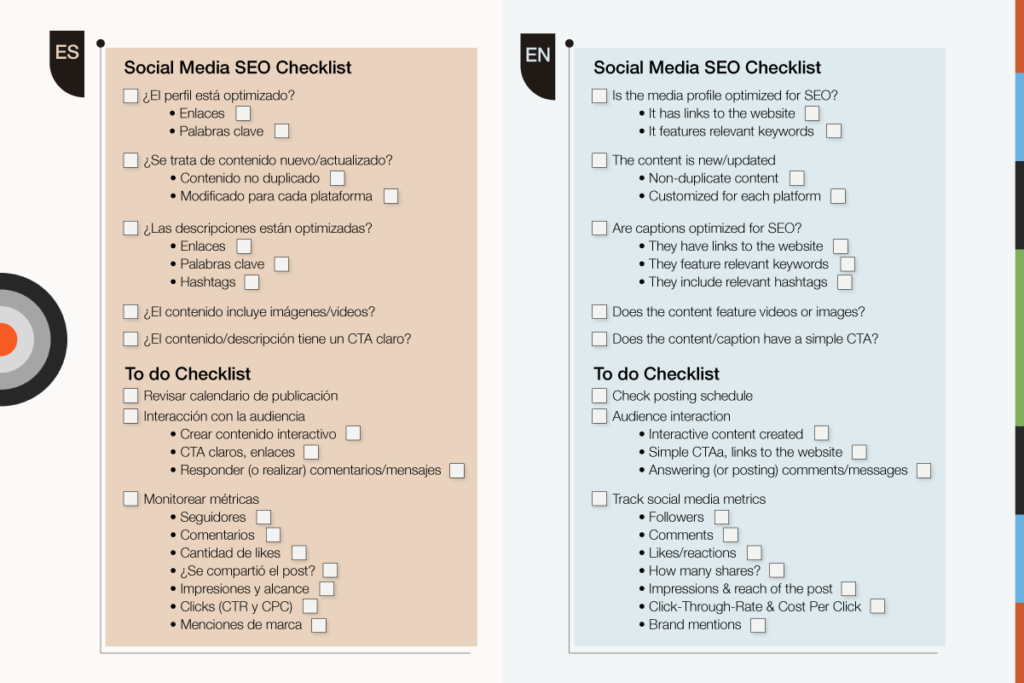
Conclusion: The Value of Social Media SEO in Your Digital Strategy
It’s undeniable that social media is here to stay, playing an increasingly important role in our daily lives. Incorporating Social Media SEO into your digital marketing strategies is a way to fully leverage market trends.
Social Media SEO not only helps you appear in search results within a social network but also indirectly improves your position on search engines.
The strategies that can be applied to achieve this range from using links and keywords to fostering user interaction. It’s certainly complex, but not impossible.
Especially since there are tools to ease this process… and because we can all set up an account to practice, practice, and master Social Media SEO, applying it to the accounts we really want to rank.
Are you ready to give it a shot? No? Come on, try it! What’s the worst that could happen? Nothing. And the best? You learn to manage your social networks in the expanding microcosm of the web—and succeed.
Of course, if you don’t have the time, another option might be more convenient.
At MD Marketing Digital, we are an agency specializing in the comprehensive development of online positioning and promotion strategies. Our team of professionals includes, of course, Social Media SEO specialists.
We are passionate about web marketing. We stay up to date with the latest trends to provide you with quality service tailored to your needs, supporting you at every stage of your digital growth.
Contact us for more information or leave your questions in the comments—we’d love to hear from you!
Social media is evolving, and with it, your presence online. Are you going to fall behind?
- Best Email Marketing Agencies in Argentina: MD Ranking - April 14, 2025
- Top 10 Best Web Design and Development Agencies in Argentina - April 7, 2025
- MD Marketing Digital Ranking Research Methodology - February 7, 2025
¿Qué te pareció este artículo?
What do you think about this post?







